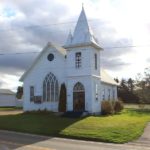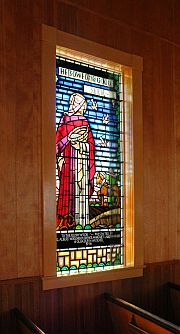1895 –  The first Presbyterian Church was built on the present former church property – moved from the present Sterling W. I. Hall site – this was the site of the first Presbyterian Church in Stanley Bridge – built in 1868.
The first Presbyterian Church was built on the present former church property – moved from the present Sterling W. I. Hall site – this was the site of the first Presbyterian Church in Stanley Bridge – built in 1868.
1925 – Members of the Presbyterian Church decided to disband and join with the Methodist and Bible Congregations to form the new United Church of Canada – this was to be situated in the newest church located at the present site
1929 – July 31 – the church burned in a disastrous fire which destroyed most of the buildings close to the Stanley Bridge corner. The Kensington Fire Department was called but after using the water in their tank they refilled at the Stanley Bridge bridge, the lines clogged with sea-weed. Any help was quickly ended. As the fire had started high in the steeple and was burning from the top downward, the people of the community quickly removed all furnishings and stored them away from the site.
The members of the congregation moved back to the present hall to hold services while a new structure was built. The design of the new building was similar to the one destroyed by fire. This would accommodate the same design – probably to make sure that they could use all the furnishings  as well as encompassing the two aisles. It is ironic to note that in the Church Minutes of September 14, 1928, a motion was passed to have the “high spire lowered at once” . Wet weather in the autumn delayed the project too long and the building was lost
as well as encompassing the two aisles. It is ironic to note that in the Church Minutes of September 14, 1928, a motion was passed to have the “high spire lowered at once” . Wet weather in the autumn delayed the project too long and the building was lost
1930 – This was the beginning of the ‘Great Depression” years. Money was scarce- a formidable task faced the community in raising money for building a new church. They agreed to proceed and secured loans for $4300.00 and $500.00 from the Home Mission Board. This was the approximate cost of the building, Many social events such as concerts, and suppers were held at the Hall. They were very ingenious in thinking of ways to raise money for their project. At the same time the members worked to keep the groups attend the many evening meetings in Scouts, Guides, Mission Band, or Young People’s . The adult meetings were also held on a regular basis.
1930 – August 3, 1930. Many residents and labourers were treated to an extra-ordinary happening in the village. Men left the saws and hammers from their work at the new church building – women left their bread in the oven and many others who heard the commotion rushed to the Stanley Bridge wharf to see an unusual sight. A seaplane had landed ! The owner was a former resident of the village, Ray Clark. His plane was not working properly so he decided to come down in the New London Bay. The engine trouble was quickly corrected and Ray and his co-pilot took to the air. One can only imagine the thoughts of these people when they saw something that would lighten their conversations and help them dream of better days ahead.
1930 – November 9, 1930 was the official opening of the new edifice. There were three services held that day, and the Clergy who came from Charlottetown, came by train to Breadalbane. Here they were met by members of the congregation and were and guests of the residents for the week-end.
There were three services held that day, and the Clergy who came from Charlottetown, came by train to Breadalbane. Here they were met by members of the congregation and were and guests of the residents for the week-end.
1939 -1945 – For those who left to take up the fight during the Second World War, the residents packed supply boxes which would ensure that those who were serving Overseas would not be forgotten in their efforts to keep democracy in this country. Boxes sent to the soldiers included fruitcake, chocolates, cigarettes, soap, toiletries, knitted socks and scarves. At the end of the War and Honour Roll was compiled, framed and placed in the church.
As the War concluded a definite transition was seen in the majority of villages across the Island. Now education was accessible for all at a minimal price – or, for Veteran’s – it was free. Young people were taking advantage of this and were successfully completing their education at the Colleges in Charlottetown or moving off-Island to gain a better life for their family.  Immediate employment was guaranteed for those who would move to other areas of the country. No longer would the small farm provide a living for a large number of people in a family. Consequently , an exodus of people began. Trade Schools were opening up in many areas. These same people were moving to the Industrial production factories, especially in automation, farm machinery, or electronics. Others went to Western Canada and quickly found employment. The changes within the education fields, easier ways of travel, and the industrial businesses, effectively diminished the support for the continuation of many activities within our community. The school system was being consolidated to larger areas. The local rinks, as well as local doctors were being centralized. Even our Swimming Lessons were moved from the village to using the large pool in the towns Attendance in the churches was no different. The children of the local families were being located in large centres, so now the parents followed to become active members of the larger area.
Immediate employment was guaranteed for those who would move to other areas of the country. No longer would the small farm provide a living for a large number of people in a family. Consequently , an exodus of people began. Trade Schools were opening up in many areas. These same people were moving to the Industrial production factories, especially in automation, farm machinery, or electronics. Others went to Western Canada and quickly found employment. The changes within the education fields, easier ways of travel, and the industrial businesses, effectively diminished the support for the continuation of many activities within our community. The school system was being consolidated to larger areas. The local rinks, as well as local doctors were being centralized. Even our Swimming Lessons were moved from the village to using the large pool in the towns Attendance in the churches was no different. The children of the local families were being located in large centres, so now the parents followed to become active members of the larger area.
1950 – 1990 – Electricity was placed in the church in 1955 – from the legacy of Hannah. G. Fyfe R. N. A Memorial Electric organ was donated by Herbert and Maude MacEwen A lighted sign-board donated by Mrs. Carrie Brown Mortgage burned for the present building in 1956
Herbert and Maude MacEwen A lighted sign-board donated by Mrs. Carrie Brown Mortgage burned for the present building in 1956
1996 – Maritime Electric stopped the men from ’Atlantic Drywalling’ from painting the spire of the church – the lines were too close to the building – same problem exists today.
2008 – Stanley Bridge United Church was decommissioned in September, 2008 because of the declining membership and financial costs to maintain the building.
2009 – The United Church Presbytery of PEI and Maritime Conference decided in 2009 to officially turn the building over to the former members of the church and they were incorporated as the Stanley Bridge Memorial Society Inc.
2012 – Maritime Electric rep. says they will ‘fix’ the problem of the wires being too close to the church when we know what we are going to do with the building.

Due to the declining number of residents in the area, the church closed on September 25, 2008 The building today is under the ownership of the Memorial Society. The building is structurally sound, This group has decided, as there is no foundation under the building, to proceed with designing a new foundation to house a Resource Center and Archives centre as well as an arts and cultural centre. The main floor is not in need of major construction. However, we are hoping to keep it as a non-denominational wedding chapel. It may also provide a place for other occasions. We are very conscious of the fact that the Women’s Institute building provides many opportunities for gatherings. The new facility will not conflict with their mandate.